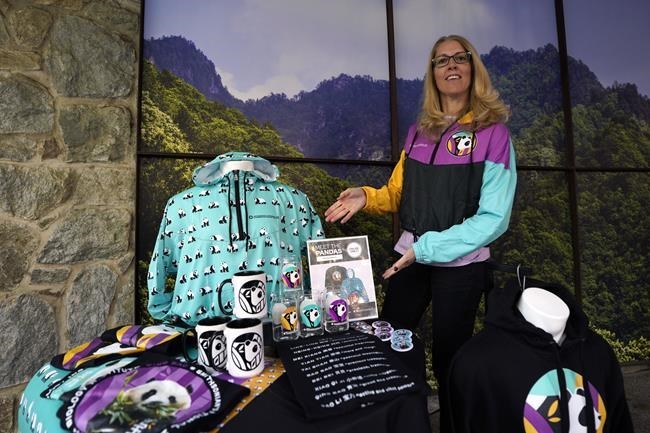
Smithsonian's National Zoo and Conservation Biology Institute (NZCBI) staff hold a media event regarding the arrival of two giant pandas from China, male Bao Li and female Qing Bao, at the National Zoo, Wednesday, Oct. 16, 2024, in Washington. The newly arrived bears will be quarantined from the public for at least 30 days.(AP Photo/Yuri Gripas)
October 16, 2024 - 11:14 AM
WASHINGTON (AP) — Washington's newest power couple, Bao Li and Qing Bao, are settling into their new home at the National Zoo. The giant pandas will remain off-limits through early next year, when the zoo will unveil its newly renovated panda house to the public.
When can we see them?
Not for a while. The bears will undergo several weeks of quarantine and medical checks as they slowly acclimate to their new environment. In addition to the zoo's small army of caretakers and panda experts, a keeper and veterinarian from China accompanied the bears and will be staying in Washington for about a month.
The zoo has set Friday, Jan. 24, 2025, as the public debut of the pandas, with a public celebration of the new arrivals from Jan. 29 to Feb. 9. Zoo members will have a chance to reserve tickets for a preview between Jan. 10 and Jan. 19.
How are they getting along?
Not at all, so far. But that's by design.
The three-year-old bears basically met for the first time while they were being transported from China and are being kept apart at the National Zoo. This is consistent with normal panda behavior in the wild. Adult pandas live in almost completely solitary. Adult males and females only really interacting during the 48-hour annual period when the female is receptive to breeding.
The panda enclosure at the zoo is built so that Bao Li and Qing Bao can happily lead entirely separate lives. Panda mothers and their cubs generally stay together for about two years before separating.
What do they eat?
Pandas are pure herbivores and enjoy a wide variety of fruits and vegetables. But their absolute staple is large quantities of bamboo. Without enough bamboo in their diets, pandas can quickly become ill. The zoo gets its bamboo supplies from its partner facility, the Smithsonian Conservation Biology Institute and also from about 15 stands in the greater Washington, D.C., area. And no, private individuals cannot donate bamboo.
Panda Babies?!?
Relax, let's all give them a little privacy for now.
Bao Li and Qing Bao are both three years old and around two years away from sexual maturity. The pair were chosen for their genetic compatibility, but pandas are notoriously fussy about mating and there's no guarantee that nature will simply take its course. If necessary, the medical staff at the zoo have deep experience with artificial insemination and used the procedure to successfully produce Xiao Qi Ji in 2020.
Is that bear a nepo baby?
Technically yes, although it's unclear whether having parents in the industry gives a panda a leg-up in the market. Bao Li is the child and grandchild of previous National Zoo pandas. His grandparents, Mei Xiang and Tian Tian, returned to China last year along with his young uncle Xiao Qi Ji; his mother Bao Bao was born at the National Zoo in 2013 and sent to China in 2017 as part of the zoo's agreement with the Chinese government. Bao Bao gave birth to Bao Li and his twin brother Bao Yuan in China in August 2021.
What about the Panda Cam?
The wildly popular Panda Cam will re-start on Jan. 24 as well, with 40 cameras tracking the bears' movements. The livestream will broadcast from 7 a.m. to 7 p.m. and rebroadcast the day's footage overnight. The zoo has beefed up its electronic infrastructure in preparation for the expected crush of online pandaphiles. A massive wave of onlookers basically overloaded the Smithsonian's servers when Xiao Qi Ji was born on camera in 2020.
Brandie Smith, the zoo's director, said they considered starting the cam early before the bears made their public debut. The zoo, however, “wanted to give the pandas and the keepers extra time to get to know each other without the world watching,” Smith said.
What is the zoo's agreement with China?
The National Zoo has signed a 10-year cooperation agreement with the Chinese authorities under which it annually pays half a million dollars per bear. Any cubs born in overseas facilities incur an additional fee and the cubs are sent to China to take part in panda conservation and breeding programs there before they reach age four.
What's new at the panda exhibit?
The National Zoo has been busy during the 11 months since the previous occupants — Mei Xiang, Tian Tian and their cub Xiao Qi Ji — returned to China last November. The outdoor panda enclosure looks largely the same with some fresh fences and a new wooden climbing feature added. The real changes are indoors, where the zoo launched a multi-million dollar upgrade and renovation even before the latest cooperative agreement was struck to bring giant pandas back to Washington, D.C.
News from © The Associated Press, 2024